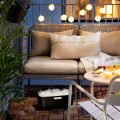Endometrial polyps, also known as uterine polyps, are abnormal growths in the endometrium, which lines the uterus. Excessive growth causes the production of polyps. Uterine polyps are more frequent in women who have gone through menopause, but younger people can also develop them. You can have a single polyp or several.
Endometrial polyps are linked to the inner wall of your uterus by a thin base or stalk that links to the endometrial lining. Polyps can be as little as a seed or as large as a ping pong ball.
Endometrial polyp irritates the uterine tissues, which can cause pain and irregular bleeding. The majority of endometrial polyps are benign or not malignant.
However, a tiny percentage may be malignant or precancerous, therefore they must be removed and sent to a lab for analysis. Endometrial polyps should be evaluated by your gynecologist through a complete consultation and examination in order to make an appropriate diagnosis and treatment plan. It could be a symptom or indication of a serious sickness or condition.
Checking For Polyps
It is not unusual to be unaware of uterine or cervical polyps; not everyone experiences symptoms. The most common sign is abnormal or patchy bleeding.
With bleeding polyps, you may see:
- Periods that take longer than they should;
- Breakthrough bleeding or bleeding when you don’t have your period;
- A heavier than usual or extremely heavy flow during your period;
- Postmenopausal hemorrhage;
- Infertility is the inability to become pregnant.
Symptoms may include spotting, pelvic pain, and difficult periods.
Testing for Polyps
Because polyps cause minimal symptoms, the best method to diagnose and cure them is for a gynecologist to schedule several tests. Many of these tests necessitate light sedation or local anesthetic. All of these operations are minimally invasive, leaving no scars and requiring only roughly 24 hours to recuperate.
- Sonohysterography, also known as hysterosonography, involves inserting a tube containing sterile saline into your uterus to clarify the images produced by a sonogram machine. This test is used by your doctor to determine whether or not your uterus contains any polyps or masses. This test should cause minimal discomfort, though some women may have period-like cramps afterward. The ideal time to schedule this test is seven to ten days after your period finishes. It would be helpful if you were not on your period or pregnant when taking this test. For a few days after the test, the utilized fluids will ooze out of your vagina during the day. Some of it may appear bloody, but that’s normal;
- An endometrial biopsy is the excision of a small tissue sample from your endometrium. Your doctor will scrape the endometrial biopsy polyp and submit it for testing to rule out malignancy. It may be required if you are over 35 years old, have abnormal uterine bleeding, or have a family history of uterine cancer. This procedure may cause cramping during the test and a tiny amount of bleeding afterward. Post-procedure bleeding and cramping are not uncommon. Mild pain medicines like ibuprofen (Motrin) or acetaminophen (Tylenol), which do not cause bleeding, can help you get through the discomfort;
- Hysteroscopy is a treatment that uses a tiny camera to see inside your uterus while you are sleeping peacefully;
- A routine pelvic exam may assist your doctor to detect polyps, particularly if you discover one on the cervix;
- A Pap smear, a common test, may identify abnormal cells if you have polyps.
- Ultrasound is another technique that can reveal lumps in the uterus. It creates visuals using sound waves from the outside by stroking a wand over your abdominal area. This test allows your local OBGYN to look for ovarian abnormalities as well as uterine polyps.
- Transvaginal ultrasound is identical to regular ultrasound. This exam entails inspecting your vaginal interior. It employs a vaginal probe rather than a wand on the outside of your abdomen;
- Dilation and curettage (D&C) is a procedure in which your doctor carefully cleans your uterine walls to collect endometrial samples. Polyps on the cervix or in the vagina can be detected at this time;
- A hysterosalpingogram (HSG) is a procedure that involves injecting dye into your uterus. X-rays show whether there are any polyps.
Polyps can return, and they are more common in those who have previously had polyps and had them removed. It is critical to see your gynecologist on a frequent basis, especially if you have any polyp-related symptoms.






































No Comments